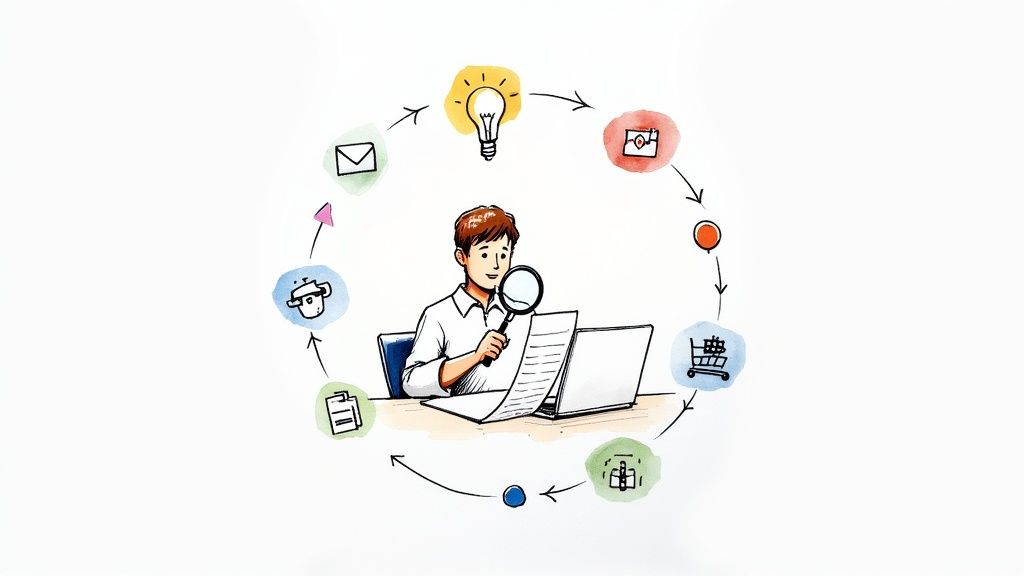
How to Improve Customer Engagement for SMBs
Discover how to improve customer engagement with practical strategies. Learn to personalize experiences, use AI, and build lasting customer loyalty.

Getting new business leads in 2025 can feel like a puzzle, especially when you're trying to keep costs down. But guess what? There are plenty of smart ways to find people who are actually interested in what you offer, without spending a fortune. We're talking about strategies that work, plain and simple. This guide breaks down how to get new business leads by using what you already have and connecting with people in ways that feel natural. Forget complicated stuff; let's focus on getting you more customers.
So, you want more business leads without constantly shelling out cash for ads? That's where organic channels come in. Think of it as building a garden instead of buying flowers. It takes a bit more time and consistent effort, but what you grow can be way more sustainable and, honestly, often leads to better quality connections. Organic leads tend to trust your brand more because they found you through helpful content or a genuine recommendation, not just because you paid to be in front of them. Plus, studies show they can convert up to twice as well as paid leads. It’s about being found when people are actually looking for what you offer.
Your website is like your digital storefront. If people can't find it when they search online, it's like having a shop hidden down a back alley with no sign. Getting your site to show up higher in search results, especially on Google, is a big deal. This isn't about tricking the system; it's about making your site clear, useful, and relevant to what people are searching for. When someone types in a question or a problem that you solve, you want your website to be one of the first things they see.
Here’s a quick rundown of what helps:
Making your website easy for search engines to understand and easy for people to use is a continuous job. It's not a one-time fix, but the payoff in consistent, free visibility is huge.
Content marketing is basically about creating stuff that people actually want to consume – articles, guides, videos, whatever. Instead of just shouting about how great your product or service is, you're showing people how you can help them solve a problem or learn something new. This builds trust. If you consistently put out helpful information related to your industry, people will start to see you as a go-to resource. When they eventually need what you offer, you'll be top of mind.
Think about your ideal customer. What are their biggest challenges? What questions do they have? Create content that directly addresses these points. For example, if you sell accounting software, you could write blog posts about common tax mistakes small businesses make, or create a downloadable checklist for year-end bookkeeping.
Remember to make your content easy to find on your website and promote it on social media. It’s a slower burn than ads, but the leads you get are often more serious about what you do because they’ve already engaged with your helpful content.
This is about showing up where your potential customers hang out online and being a helpful member of the group. Forget just dropping links; focus on genuine interaction. Think Reddit, Quora, industry-specific forums, or even Facebook groups. The goal is to become a known, trusted voice.
How do you do this? Start by listening and answering questions. If someone asks about a problem you can solve, offer a thoughtful, helpful answer. Share your knowledge without expecting anything immediately in return. Over time, people will start to recognize your name and associate you with helpful advice. You can then subtly guide interested people to your website or a relevant resource through your profile or a signature link, but only after you’ve established some credibility.
Building relationships in online communities takes time and consistency. It’s not about quick wins, but about laying the groundwork for long-term trust and referrals.
Sometimes, the best new business leads come from people who already know and trust you. It’s about building on existing connections. Think about it: when a friend recommends a restaurant or a service, you're way more likely to try it out, right? The same applies to business. Getting your current customers and partners to spread the word can bring in some really solid leads.
Launching a referral program is a smart move. You want to make it easy and rewarding for your happy customers to tell others about you. What kind of reward works best? It could be a discount on their next purchase, a small bonus, or even early access to something new. It's a good idea to offer something to the person making the referral and maybe a little something to the new person they bring in, too. You'll need a system to track these referrals, maybe through your CRM or a simple landing page. A healthy referral rate, meaning the percentage of your business that comes from referrals, is often around 10%, but this can change depending on your industry. Don't forget to let your existing customers know about the program – mention it in your emails or on your website. And remember, you probably won't get it perfect on the first try. Keep tweaking the incentives and how you ask for referrals to see what works best.
This is all about creating such a good experience that people want to talk about you. It starts with providing excellent service and a great product, of course. But you can also actively encourage it. Sharing success stories from happy clients can inspire others to become advocates. Publicly thanking customers who refer others can also go a long way. It shows you appreciate their support and encourages more of it.
Building genuine connections means people feel comfortable recommending you. It's not just about the transaction; it's about the relationship you build along the way. When people trust you, they become your best salespeople.
Teaming up with other businesses can open doors to new customers. Look for companies that serve a similar audience but don't directly compete with you. You could co-host a webinar, create a joint guide, or even promote each other's services to your respective customer bases. For example, a web designer might partner with a copywriter, or a marketing agency might team up with a business consultant. These partnerships can introduce you to a whole new group of potential clients who are already interested in what you offer. It's a way to share audiences and build credibility through association.
Social media isn't just for sharing vacation photos anymore; it's a serious place for businesses to find new customers. If you're not active on platforms where your potential clients hang out, you're probably missing out on a lot of opportunities. It's about being present, being helpful, and making it easy for people to learn more about what you offer.
For anyone selling to other businesses, LinkedIn is pretty much non-negotiable. Think of it as the digital handshake for the professional world. Your company page and your personal profile should both look sharp and clearly state what you do and who you help. Posting regularly with useful information – not just sales pitches – is key. Engage with posts from others in your industry, join relevant groups, and answer questions. This is where you build credibility and get noticed by the right people.
LinkedIn is a powerful tool for B2B lead generation when used consistently and strategically. It's about building relationships and demonstrating value, not just broadcasting your services.
While LinkedIn is great for B2B, don't forget other platforms. Where do your customers spend their time online? Is it Instagram, Facebook, Twitter, or maybe even TikTok? You need to be there too. The trick is to tailor your content to each platform. What works as a long article on LinkedIn might need to be a short video or a catchy graphic elsewhere. The goal is to create content that people actually want to see and interact with.
Just posting isn't enough; you have to interact. When people comment on your posts, reply to them. If someone asks a question, answer it. This shows you're listening and that you care. You can also use features like polls, Q&A sessions, or live videos to get people involved. Sharing customer success stories or testimonials can also be really effective. It builds trust when potential clients see that others have had good experiences with you. Remember, social media is a two-way street. The more you give value and engage, the more likely people are to consider doing business with you.
Okay, so you've got people interested, maybe they've visited your site or clicked on an ad. Now what? You don't want them to just disappear into the digital ether, right? That's where building and taking care of your email list comes in. Think of it as your direct line to potential customers, a way to keep the conversation going long after they've left your website. It’s about building a relationship before you even try to make a sale.
So, how do you get people to actually give you their email address? You've got to offer them something good, something they actually want. This is where lead magnets shine. They're basically freebies that solve a small problem or provide a bit of useful info in exchange for an email. Forget generic stuff; think about what your ideal customer is struggling with right now.
Here are some ideas:
The key is to make your lead magnet super specific and genuinely helpful. It should give a taste of the value you provide without giving everything away. You can find more ideas for building your list from scratch here.
Sending the same email to everyone on your list is like shouting into a crowded room – some people might hear you, but most will tune you out. Segmentation is all about dividing your list into smaller groups based on shared characteristics or behaviors. This lets you send messages that are way more relevant to each person.
Think about how you can split your list:
When you personalize your messages, people are more likely to open them, click through, and eventually become customers. It shows you're paying attention and you understand their needs.
Once you've got subscribers and you've started segmenting, the real work begins: keeping them engaged. This isn't about sending sales pitches every other day. It's about consistently providing value that keeps you top-of-mind and builds trust. Your email list is your direct line to high-quality, sustainable lead generation.
Here’s how to keep the value flowing:
The goal is to become a trusted resource, not just another company in their inbox. When you consistently offer helpful information, people will look forward to your emails and be more receptive when you do have something to sell.

Okay, so let's talk about AI and automation. It sounds super high-tech, right? But honestly, it's becoming a pretty normal part of how businesses find new customers these days. Think of it as having a really smart assistant that can do a lot of the grunt work for you, so you can focus on the actual selling or building relationships.
This is where AI really shines. Instead of just guessing who might be interested in what you offer, AI tools can sift through tons of data to find patterns. They can look at things like a company's size, industry, recent news, or even their online activity to figure out who's most likely to buy. It's like having a superpower for spotting potential customers. These tools help you zero in on the right people, saving you a ton of time and effort.
Once you've identified some leads, the next step is to reach out. This is where automation comes in handy. You can set up systems that automatically send out emails, schedule follow-up reminders, or even send personalized messages based on what you know about the lead. This means no more forgetting to call someone back or letting a good lead slip through the cracks because you were too busy. It keeps your pipeline moving without you having to manually track every single step.
Now, you might think automation means everything becomes generic and impersonal. But that's not the case with modern AI. These tools can actually help you personalize your outreach much more effectively, even when you're contacting hundreds or thousands of people. They can pull in specific details about a prospect – like their company's recent achievements or a specific problem they might be facing – and weave that into your message. This makes your outreach feel much more relevant and less like a mass blast. It's about being smart with your communication, not just sending out more of it.
Here's a quick look at how AI and automation can help:
The key is to use these tools to augment your efforts, not replace the human touch entirely. AI can find the needles in the haystack and help you craft the initial message, but building a real relationship still requires genuine interaction.

No matter how hard you work on bringing in new business leads, not tracking and improving your process is like shooting in the dark. You want to know what’s actually working and what’s holding you back. Let’s break down the basics—KPIs, analytics, and A/B testing—to make sure your lead generation keeps moving forward.
To make real progress, decide exactly what success means for your lead generation. Maybe you want more qualified leads, a lower cost per lead, or a better conversion rate. List out a few clear KPIs that fit your goals, like:
If you're looking to see direct business benefits, measuring things like Return on Investment (ROI) provides insight into which campaigns bring in actual profit.
Gone are the days of guessing. Use tools—Google Analytics or a CRM—to see what’s really happening behind the scenes. Check which traffic sources send you the most qualified people and which pages move visitors to action.
Here’s a sample table showing how you might track key metrics month-over-month:
Try breaking down your data regularly:
Data doesn’t need to be perfect, but regular check-ins make it much easier to spot what’s working and where you’re losing steam.
Here’s where things get interesting. Don’t just guess—test everything. Run simple A/B split tests on headlines, CTAs, emails, or even the color of your buttons. Sometimes, a word or a color switch can drive a surprising jump in results. A simple process:
And remember, optimization is ongoing. Measure, tweak, repeat—this is how good lead generation becomes even better over time.
So, we've gone over a bunch of ways to get new business leads in 2025 without spending a lot of money. Remember, it's not about doing everything at once. Pick a few strategies that make sense for your company and stick with them. Things like using social media well, asking happy customers for referrals, and building an email list can really make a difference. It takes time and effort, but by consistently trying these methods and seeing what works best, you'll start bringing in more potential customers. Don't forget to track your progress and adjust as you go. This approach will help your business keep growing.
In 2025, you can get new business leads without spending money by using strategies like making your website easy to find on Google (SEO), asking happy customers to tell their friends about you (referrals), and being active on social media. Offering a freebie, like a helpful guide, in exchange for an email address is also a great way to collect contacts.
Organic leads, which come from methods like SEO or content marketing, often trust your business more and are more likely to become customers. Studies show they can convert twice as well as leads from paid ads, meaning you get more customers for your efforts.
AI can help by suggesting what content to create, identifying potential customers, and even sending automated emails. Tools like chatbots can talk to visitors on your website, and AI can help personalize messages to many people at once, saving you time and making your efforts more effective.
Yes, it's very important! Relying on just one method to get leads is risky. If that method stops working, you could lose all your new leads. Using a mix of strategies, like content marketing, social media, and referrals, creates a stronger and more reliable way to keep your business growing.
Some common mistakes include putting all your effort into just one channel, not following up with people who show interest, and not keeping track of what's working. It's also a mistake to focus on things like website visits instead of actual customers gained.
You should set clear goals, like how many people should sign up for your email list or request a demo. Use free tools like Google Analytics to see where your leads are coming from and how they behave on your site. Regularly check these numbers and test different approaches to see what brings the best results.